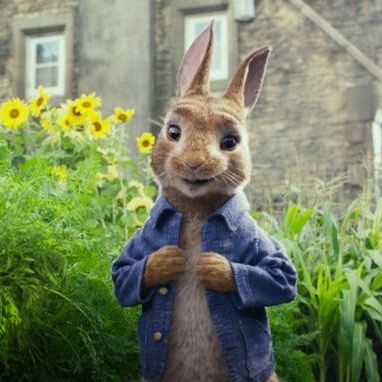
If you squint hard enough at the classic cornflower-blue jacket that has been worn by beloved British troublemaker Peter Rabbit since 1902, it could almost be a jean jacket. This is more or less the premise of Peter Rabbit, an animated/live-action hybrid directed and co-written by Will Gluck that seeks to reframe the tale of grumpy gardeners and purloined parsley as Country Home Alone. It is the most American “British” movie I’ve seen in a while, and not just for the crudeness of its hijinks. After all, a gentle and sweet Paddington-esque adaptation would have been all wrong; Peter Rabbit is a children’s book about a boy who disobeys his mother, steals produce, is stripped of his clothes and chased by a man who wants to kill and eat him, and finally returns home, where his mother gives him a sedative and sends him to bed without dinner. It calls for a bit of an eye for malevolence, but there’s malevolence, and then there’s a CGI rabbit attempting to stick a carrot down an elderly Scotsman’s butt crack.
One piece of good news: the CGI rabbits (and badgers and hedgehogs, including one voiced by Sia) are extremely cute. Like, “search adoptable rabbits on Petfinder.com” cute. This is not trivial; the visual lovability of Peter Rabbit is paramount to his success as an agent of chaos; his adorability is the much-needed tempering to all that aforementioned darkness. In this tale, which is emphatically not The Tale of Peter Rabbit, Mr. McGregor (Sam Neill) keels over from a heart attack within the first 15 minutes, and Peter (voiced by James Corden) and his family are left to contend with his heir, Thomas (Domhnall Gleeson, sure, but why?), a fastidious ex-Harrods manager. He arrives with the intent to sell the estate, but ends up falling for his neighbor — and Peter’s human benefactor — “Bea” (Rose Byrne, trying to make this all look normal), an artist who adores the rabbits and paints portraits of them, wink wink. The film is essentially a stepfather story, with Gleeson as the intrusive out-of-his-element new daddy and Peter as the suspicious son, and the two bludgeon, strangle, electrocute, and eventually detonate explosives at each other until it all inevitably goes too far and they must learn to live with one another.
It’s hard to believe, but this is Peter’s big-screen debut — people have been trying to get a Peter Rabbit movie made since Walt Disney was turned down by Beatrix Potter herself in 1936. Maybe she should have taken him up on it. The film is a constant, uncomfortable tug-of-war between slapstick and naturalism; much of it is shot in a loose semi-handheld framing that is rather distracting with all the digital furballs running around. But there’s a kind of disconnect between the relatively realistic renderings of Peter, Flopsy, Mopsy, Cottontail, and Benjamin and the voice acting, to the degree that it’s not always clear which character is talking in anything wider than a medium shot.
This is actually a pretty big technical problem, compounded with an artistic one. Potter’s anatomically correct illustrations never suggested the kind of wisecracking chattiness that desperately wallpapers Gluck’s film. The script constantly vamps with boilerplate “that’s not a thing”–esque jokes, the kind of quips that sound like they’re supposed to be funny but don’t actually require any writing or wit. (The one exception is a recurring bit involving a rooster’s morning exclamations that is essentially just a modified Far Side panel but made me laugh nonetheless.) It’s so insistent that this isn’t your great-grandmother’s Peter Rabbit — while, again, not straying from the original character design all that much — that it feels like the animators are at war with the writers, and the loudest of the two groups tends to win out at every turn.

